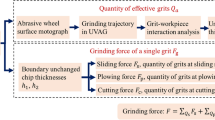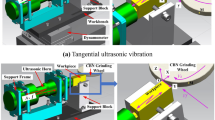Abstract
Based on the micro-removal mechanism of the ultrasonic vibration-assisted grinding (UVAG), a new prediction model of alloy structural steel is proposed in this paper. In the grinding process, the abrasive grains mainly go through two stages: plowing stage and chip forming stage. Then, grinding force model of single grain under different material removal modes is established. The thickness of the abrasive grain, the number of grains involved in grinding, and the interference between the abrasive grains are essential factors that affect the grinding force. Considering the influence of ultrasonic vibration on these factors, the grinding force model of the grinding wheel is developed. The ultrasonic grinding experiments are conducted to validate this model. Findings show that the theoretically predicted results are consistent with the experimental results.
Similar content being viewed by others
References
Dambatta YS, Sarhan AAD, Sayuti M, Hamdi M (2017) Ultrasonic assisted grinding of advanced materials for biomedical and aerospace applications—a review. Int J Adv Manuf Technol 92(9–12):3825–3858. https://doi.org/10.1007/s00170-017-0316-z
Chen HF, Tang JY, Zhou W (2013) An experimental study of the effects of ultrasonic vibration on grinding; surface roughness of C45 carbon steel. Int J Adv Manuf Technol 68(9–12):2095–2098. https://doi.org/10.1007/s00170-013-4824-1
Ding K, Fu YC, Su HH, Cui FF, Li QL, Lei WN, Xu HX (2017) Study on surface/subsurface breakage in ultrasonic assisted grinding of C/SiC composites. Int J Adv Manuf Technol 91(9–12):3095–3105
Ding K, Fu YC, Su HH, Xu HX, Cui FF, Li QL (2017) Experimental studies on matching performance of grinding and vibration parameters in ultrasonic assisted grinding of SiC ceramics. Int J Adv Manuf Technol 88(9–12):2527–2535
Shen JY, Wang JQ, Jiang B, Xu XP (2015) Study on wear of diamond wheel in ultrasonic vibration-assisted grinding ceramic. Wear 332-333:788–793. https://doi.org/10.1016/j.wear.2015.02.047
Tawakoli T, Azarhoushang B (2008) Influence of ultrasonic vibrations on dry grinding of soft steel. Int J Mach Tools Manuf 48(14):1585–1591
Tawakoli T, Azarhoushang B, Rabiey M (2008) Ultrasonic assisted dry grinding of 42CrMo4. Int J Adv Manuf Technol 42(9–10):883–891. https://doi.org/10.1007/s00170-008-1646-7
Wang Y, Lin B, Cao X, Wang S (2014) An experimental investigation of system matching in ultrasonic vibration assisted grinding for titanium. J Mater Process Technol 214(9):1871–1878. https://doi.org/10.1016/j.jmatprotec.2014.04.001
Rowe W (2009) Principles of modern grinding technology. William Andrew, Burlington
Liu D, Cong WL, Pei ZJ, Tang Y (2012) A cutting force model for rotary ultrasonic machining of brittle materials. Int J Adv Manuf Technol 52(1):77–84. https://doi.org/10.1016/j.ijmachtools.2011.09.006
Wang Y, Lin B, Wang S, Cao X (2014) Study on the system matching of ultrasonic vibration assisted grinding for hard and brittle materials processing. Int J Mach Tools Manuf 77:66–73. https://doi.org/10.1016/j.ijmachtools.2013.11.003
Ning F, Cong W, Wang H, Hu Y, Hu Z, Pei Z (2017) Surface grinding of CFRP composites with rotary ultrasonic machining: a mechanistic model on cutting force in the feed direction. Int J Adv Manuf Technol 92(1–4):1217–1229. https://doi.org/10.1007/s00170-017-0149-9
Cong WL, Pei ZJ, Sun X, Zhang CL (2014) Rotary ultrasonic machining of CFRP: a mechanistic predictive model for cutting force. Ultrasonics 54(2):663–675. https://doi.org/10.1016/j.ultras.2013.09.005
Li C, Zhang F, Meng B, Liu L, Rao X (2017) Material removal mechanism and grinding force modelling of ultrasonic vibration assisted grinding for SiC ceramics. Ceram Int 43(3):2981–2993. https://doi.org/10.1016/j.ceramint.2016.11.066
Xiao X, Zheng K, Liao W, Meng H (2016) Study on cutting force model in ultrasonic vibration assisted side grinding of zirconia ceramics. Int J Mach Tools Manuf 104:58–67. https://doi.org/10.1016/j.ijmachtools.2016.01.004
Zhang JH, Li H, Zhang ML, Zhao Y, Wang LY (2017) Study on force modeling considering size effect in ultrasonic-assisted micro-end grinding of silica glass and Al2O3 ceramic. Int J Adv Manuf Technol 89(1–4):1173–1192. https://doi.org/10.1007/s00170-016-9148-5
Li S, Wu Y, Nomura M (2016) Effect of grinding wheel ultrasonic vibration on chip formation in surface grinding of Inconel 718. Int J Adv Manuf Technol 86(1–4):1113–1125. https://doi.org/10.1007/s00170-015-8149-0
Tang J (2016) Modeling on grinding force assisted with axial ultrasonic vibration. Chin J Mech Eng 52(15):184. https://doi.org/10.3901/jme.2016.15.184
Cao J, Wu Y, Li J, Zhang Q (2015) Study on the material removal process in ultrasonic-assisted grinding of SiC ceramics using smooth particle hydrodynamic (SPH) method. Int J Adv Manuf Technol 83(5–8):985–994. https://doi.org/10.1007/s00170-015-7629-6
Cao J, Wu Y, Lu D, Fujimoto M, Nomura M (2014) Material removal behavior in ultrasonic-assisted scratching of SiC ceramics with a single diamond tool. Int J Mach Tools Manuf 79:49–61. https://doi.org/10.1016/j.ijmachtools.2014.02.002
Malkin S (1989) Grinding technology: theory and application of machining with abrasives. Ellis Harwood Publication, UK
Jiang J, Ge P, Sun S, Wang D, Wang Y, Yang Y (2016) From the microscopic interaction mechanism to the grinding temperature field: an integrated modelling on the grinding process. Int J Mach Tools Manuf 110:27–42. https://doi.org/10.1016/j.ijmachtools.2016.08.004
Hou ZB, Komanduri R (2003) On the mechanics of the grinding process—part I. Stochastic nature of the grinding process. Int J Mach Tools Manuf 43(15):1579–1593. https://doi.org/10.1016/s0890-6955(03)00186-x
Halling J (1975), Principles of tribology, Macmillan, London https://link.springer.com/book/10.1007%2F978-1-349-04138-1 [Accessed: 16-Nov-2018]
Merchant ME (1945) Mechanics of the metal cutting process. I. Orthogonal cutting and a type 2 chip. J Appl Phys 16(5):267–275
Zhang Y, Li C, Ji H, Yang X, Yang M, Jia D, Zhang X, Li R, Wang J (2017) Analysis of grinding mechanics and improved predictive force model based on material-removal and plastic-stacking mechanisms. Int J Mach Tools Manuf 122:81–97. https://doi.org/10.1016/j.ijmachtools.2017.06.002
Setti D, Ghosh S, Rao PV (2017) A method for prediction of active grits count in surface grinding. Wear 382-383:71–77. https://doi.org/10.1016/j.wear.2017.04.012
Funding
The authors gratefully acknowledge the support of the National Natural Science Foundation of China (NSFC) through Grant Nos. 51535012, 51705542, and U1604255, the support of the Key Research and Development Project of Hunan province through Grant No. 2016JC2001, and the Fundamental Research Funds for the Central Universities of Central South University No. 2018zzts461.
Author information
Authors and Affiliations
Corresponding author
Rights and permissions
About this article
Cite this article
Li, D., Tang, J., Chen, H. et al. Study on grinding force model in ultrasonic vibration-assisted grinding of alloy structural steel. Int J Adv Manuf Technol 101, 1467–1479 (2019). https://doi.org/10.1007/s00170-018-2929-2
Received:
Accepted:
Published:
Issue Date:
DOI: https://doi.org/10.1007/s00170-018-2929-2




